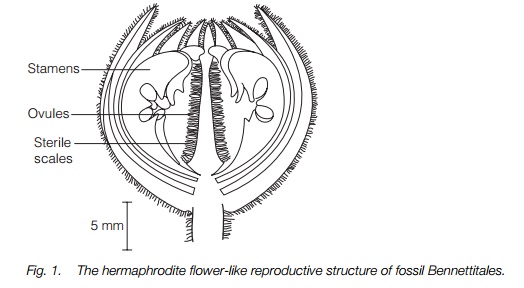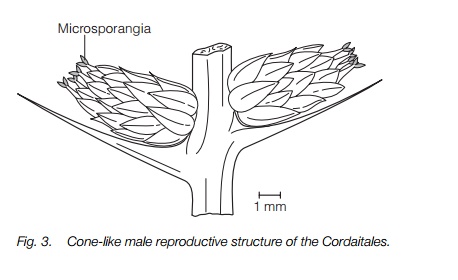Chapter: Plant Biology : Seed plants
Early seed plants: Pteridosperms, fossil seed, Bennettitales and Caytoniales
EARLY SEED PLANTS
Key Notes
Pteridosperms
The first true seed plants had leaves that resembled ferns. Abundant fossils are known from Devonian to Permian times. Some had one vascular bundle, some several and most had secondary thickening. The female gametophyte resembled that of heterosporous ferns and lycopsids.
Bennettitales and Caytoniales
These groups were common from Triassic to Cretaceous times and resembled the pteridosperms from which they probably descended. The Bennettitales had flower-like reproductive structures, the Caytoniales a cupule surrounding the ovules.
Other fossil seed plants
The Cordaitales, mainly from the Carboniferous period, resemble living conifers of today and may be ancestral to them. They were large trees with strap-like leaves and clustered reproductive structures. There were other seed plant groups without clear affinity.
Pteridosperms
The pteridosperms, or ‘seed ferns’, were the earliest seed plants . They first appear in Devonian rocks and there are abundant fossils from the Carboniferous and Permian periods. They must have been among the dominant plants. Their leaves were large and pinnate like those of ferns. They were trees or climbers, some large, and their stems were varied, some possessing a single vascular strand, others with many vascular strands but, unlike ferns, they had secondary thickening giving rise to tapered trunks. Many details of their anatomy are known and they are divided into several families.
Like all seed plants they were heterosporous retaining the megasporangia (each with one spore) on the leaves. The female gametophyte was multicellular with archegonia similar to those of heterosporous ferns and clubmosses (Topics Q2 and Q3). The integument was variable . The pollen grains were probably trapped by a drop of fluid by the gap in the integument, as seen in living cycads .
Fossil evidence suggests that their descendants include the extinct Caytoniales and Bennettitales and the living group, the cycads .
Bennettitales and Caytoniales
The Bennettitales had an unbranched or sparingly branched trunk and large pinnate, fern-like leaves like the pteridosperms. They resembled livingcycads but differed in details of leaf anatomy. They are abundantly represented in the fossil record from the Triassic to the Cretaceous period. Their reproductive structures were borne on very short separate stems on the trunks, with the ovules towards the tip. The ovules were surrounded by modified leaves bearing the microsporangia (anthers), and these anthers were surrounded by bracts making the whole structure look remarkably like a flower (Fig. 1). It is likely that some, at least, were insect-pollinated, but this structure probably arose independently from the flowers of the angiosperms.

Another fossil group, the Caytoniales, may be ancestral to the flowering plants, since the ovules, and later the seeds, were surrounded by cup-like outgrowths, known as cupules (Fig. 2), resembling the ovary of flowering plants.

Other fossil seed plants
One of the most abundant fossil seed plant groups in the Carboniferous period was the Cordaitales. They were massive trees to 30 m high with simple strapshaped leaves, often quite large but with simple traces in the vascular system. Their vegetative parts strongly resembled those of some living conifers such as the monkey-puzzle, Araucaria, and they may be ancestral to conifers. Male and female reproductive structures were separated onto different shoots, perhaps on the same tree. Shoots of both sexes had overlapping bracts (modified leaves) with sporangia at their tips (Fig. 3). Their relationships are obscure, perhaps with the pteridosperms, but their leaves resemble microphylls such as possibly those of progymnosperms . If they are related to the progymnosperms it suggests that Cordaitales and conifers may have developed the seed habit independently from pteridosperms and other groups.

There were several other groups of seed plants found only as fossils that had died out by the end of the Cretaceous period. Five groups of seed plants survive. Of these, the conifers have a fossil history extending right back to the Carboniferous, the cycads to the Triassic and the Ginkgoales as far as the Permian period. The Gnetales and the angiosperms are more recent, probably appearing first in the Jurassic period.
Related Topics